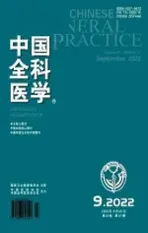澳大利亚John Murtagh 全科病案研究(三十四)——对糖尿病患者的连续诊治过程(1)
2011-08-15JohnMurtagh
John Murtagh (著),杨 辉(译)
作(译)者单位:3165 澳大利亚维多利亚州,澳大利亚Monash大学
译者按:慢性疾病患者的病程可以持续十几年甚至几十年,患病过程中的临床表现、心理健康和社会健康情况也会随着时间的推移而改变。全科医生是能够全程和连续地观察和诊治慢性疾病的卫生专业人员,根据病程发展采取各种不同的措施,帮助病人管理好慢性病。Murtagh 教授以2 型糖尿病管理为例,跟我们讨论了一个跨越10 多年的2 型糖尿病患者的病案,本期是该病案讨论的第一部分。从这个案例中,我们可以学习和思考怎样以全科医学的理论视角和实践方法,来进行社区糖尿病管理。
1 病史
13 年前,金42 岁,到全科医学诊所来体检。他是一位警察,以前身体一直很健康,不过近几个月来感到很劳累,很容易疲倦。特别是锻炼身体后,常感到疲惫不堪。最近他晋升为警督,工作更加繁忙了,而且要花更多的时间处理公务,疲劳感也就更为严重。他说感到自己力不从心,而且体重也增加了不少。他倒是没有什么其他的症状,特别是没有泌尿系统的症状。
金抽烟,每天10 支,以前有过轻度高血压病史,不过没有吃药,而是通过减少食盐和减少饮酒的方法来控制血压。
我给金做体检,他看上去还是很健康的,只是体重超重,BMI 为33 kg/m2,腰围106 cm。脉搏72 次/min,规律。血压145/90 mm Hg (1 mm Hg =0.133 kPa)。其他体检结果属正常。尿检结果:尿糖(+),未发现尿蛋白。随机血糖(指血)8.5 mmol/L。
2 问题
(1)你采用什么方法诊断金的病?如果需要的话,需要做哪些进一步检查?(2)如果你做了初步诊断,病人的哪些方面与“标准的诊断”不一样?
3 答案
问题1:你可以考虑金可能患的是2 型糖尿病。这个病人给你的第一印象是肥胖,而且他的工作性质是那种久坐不动的工作。糖尿病是一个世界范围的严重问题,患病率很高,而且呈现快速增加的趋势。然而现在仅凭他的随机血糖8.5 mmol/L 是不能下糖尿病诊断的。你需要做一个很重要的检查,就是空腹血糖(FBG)。其他应该做的检查包括空腹血脂检查、肾功能检查。你还应该根据FBG 的检查结果,进一步做葡萄糖耐量试验。
资料框:世界卫生组织糖尿病诊断指南
-空腹血糖≥7 mmol/L
-餐后随机血糖或摄入75 g 葡萄糖2 小时后血糖≥11.1 mmol/L
-如空腹血糖5.5 ~6.9 mmol/L,需要进一步做口服葡萄糖试验
问题2:2 型糖尿病的一个特点,是很多病人并不表现出临床症状。在金的案例中,病人的随机尿糖试验发现少量葡萄糖,这可以提示可能患糖尿病,但这种尿糖试验的可信度较低,很多2 型糖尿病患者的随机尿糖试验可以是阴性。因此在没有做血糖检查前,仅仅凭尿糖试验很难筛查出糖尿病。
4 对金的进一步临床检查
FBG:6.7 mmol/L,餐后2 h 葡萄糖耐量试验:12.8 mmol/L,空腹血脂:总胆固醇5.7 mmol/L,高密度脂蛋白胆固醇(HDL-C)1.0 mmol/L,低密度脂蛋白胆固醇(LDL -C)3.2 mmol/L,三酰甘油(TC)1.8 mmol/L,表皮生长因子受体(eGFR)100 ml/min。
5 进一步的问题
(3)你对金的病情评价结果是什么?(4)请列出你的治疗计划要点。
6 对进一步问题的答案
问题3:金患的是2 型糖尿病。餐后2 h 葡萄糖耐量实验结果为12.8 mmol/L,这是诊断2 型糖尿病的关键依据。金的糖尿病并非刚刚开始,而是像很多“隐形”病人一样,经过了一段没有症状的糖尿病阶段,但现在他已经开始表现出严重的症状,比如疲劳、全身乏力,随着他的生活方式变化,这些症状表现的越来越明显。文献报道,人群中大约有一半这类病人没有被诊断出糖尿病[1]。
问题4:近期的糖尿病管理计划。
-进一步检查:一定要注意到金这种糖尿病病人的并发症,因为很多病人在诊断之初就已经开始有并发症[1]。进一步的检查可以包括心血管的生命体征检查、皮肤疾病检查、足部神经学检查以及视网膜检查。另外还可以考虑尿微量白蛋白检查。在开始治疗2 ~3 个月时,最好要做糖化血红蛋白(HbA1C)检查。
-血压问题:金的血压高于糖尿病管理的控制水平(<130/80 mmHg)。如果通过改变生活方式还不能很好地控制血压,最好让他开始服用降压药,如血管紧张素转化酶抑制剂(ACEI)。
-吸烟问题:应该给金提供关于戒烟的健康教育信息,并通过动机谈话技术,帮助他戒烟。
-血糖控制:应该给病人提供饮食指导,并指导病人至少在8 周内增加身体活动,在此之后,要指导病人监测血糖和体重。
-血脂控制:金的低密度脂蛋白胆固醇高于理想值(<2.5),如果饮食控制和身体锻炼等措施还不能奏效,就应该考虑采用调脂治疗。
-口服降糖药:如果通过改变生活方式不能明显地改善血糖水平,应该让病人服用降糖药。不过从长期保健的角度看,还是应该着重于通过饮食和身体锻炼来降低血糖。
1 Dunstan DW,Zmmet PZ,Welborn TA,et al. the rising prevalence of diabetes and impaired glucose tolerance:the Australian Diabetes [J].Obesity and Lifestyle study. Diabetes Care,2002,25:829 -834.
译者注:动机谈话技术:请参见《中国全科医学》杂志近期刊登的快乐生活俱乐部——社区慢性病管理模式的研究报告。
History
Kim,aged 42 years,presents for a check up. He has enjoyed good health but in recent months feels tired and becomes easily fatigued especially after physical activity. This situation has arisen since he has been promoted to a senior police administrator and spends considerable time in the office. He feels unfit and has put on weight. He has no other symptoms particularly no urinary symptoms. He smokes 10 cigarettes per day and has a history of mild hypertension but attempts to manage it through elimination of salt and alcohol.
On examination he looks well but overweight. He body mass index is 33 kg/m2,waist circumference 106 cm,pulse 72 and regular,blood pressure 145/90 mmHg. The rest of the examination is normal. Urinalysis 1 + glucose but no protein. A random blood glucose (finger pick sample)is 8.5 mmol/L.
Questions
1 What would be your diagnostic approach to Kim and what investigations (if any)would you order?
2 What are the unusual aspects about the provisional diagnosis?
Feedback
1 You would have to consider the diagnosis of type 2 diabetes mellitus in a person who is obese and has a sedentary lifestyle. Diabetes is a massive worldwide problem and increasing at an alarming rate. Kim's random blood glucose of 8.5 mmol/L is not diagnostic of diabetes. Your key investigation would be a fasting blood glucose(FBG). Other appropriate investigations would be fasting lipid studies,kidney function (eGFR)and a glucose tolerance test (depending on the fasting blood glucose).
Box 1
WHO guidelines for diagnosis of diabetes
Fasting blood glucose ≥7 mmol/L
Random blood glucose (post prandial)or 2 hours after 75g glucose load ≥11.1 so need to perform an oral glucose test
If fasting blood glucose is 5.5 -6.9 mmol/L,diabetes is uncertain
2 A feature of type 2 diabetes is that most people with it are asymptomatic. In Kim there was a small amount of glucose in a random urine dipstick test and this pointed to the diagnosis of diabetes but the dipstick test is unreliable and many patients with type 2 diabetes test negative for urinary glucose. This made the screening for diabetes very difficult for those practising before blood glucose estimation became available.
Further clinical details for Kim
The results of investigation:FBG 6.7 mmol/L
Glucose tolerance test -2 hour post glucose level 12.8 mmol/L
Lipids (fasting):total cholesterol 5.7 mmol/L,HDL - C 1.0 mmol/L,LDL - C 3.2 mmol/L,triglyceride 1.8 mmol/L,eGFR 100ml/min
Questions
3 What is your assessment of Kim's medical condition?
4 Outline your immediate plan of management
Feedback
3 Kim has type 2 diabetes. His blood glucose level 2 hours postglucose load was 12.8 mmol/L,which is diagnostic of type 2 diabetes. Like so many people he has remained asymptomatic for a long time but he started to develop vague symptoms of tiredness and malaise in line with his changed lifestyle. It is estimated that up to one half of people with diabetes have not yet been diagnosed[1].
4 Immediate plan of management
-Examination:It is important to examine Kim for complications of diabetes since these patients can develop complications by the time of diagnosis[1]. This should include cardiovascular vital signs,the skin,neurological of the feet and retinal examination. Also perform a 'spot' urine examination for microalbumin. A HbA1C estimation is best left to about 2 to 3 months after treatment is initiated.
-Blood pressure:Kim's BP is above the target for people with diabetes (<130/80 mmHg)so if it is not controlled after a reasonable trial of lifestyle modification it would be appropriate to start medication with an angiotensin converting enzyme inhibitor(ACEI).
-Smoking:Kim should be offered information and motivational counselling about quitting smoking.
-Glucose level:a trial of dietary advice and increased physical activity for 8 weeks with monitoring of glucose control and weight during and after this time.
-Cholesterol:Kim's LDL-C is elevated above the ideal target (<2.5)so he could be considered for stain therapy if this level is not improved after a trial of diet and physical activity.
-Oral hypoglycaemic agent:if lifestyle measures do not improve his blood glucose levels consideration should be given to the introduction of medication but it is best to consider the long term and promote control with diet and physical activity.
Reference
1 Dunstan DW,Zmmet PZ,Welborn TA,et al. the rising prevalence of diabetes and impaired glucose tolerance:the Australian Diabetes,Obesity and Lifestyle study. Diabetes Care,2002,25:829 -834.
